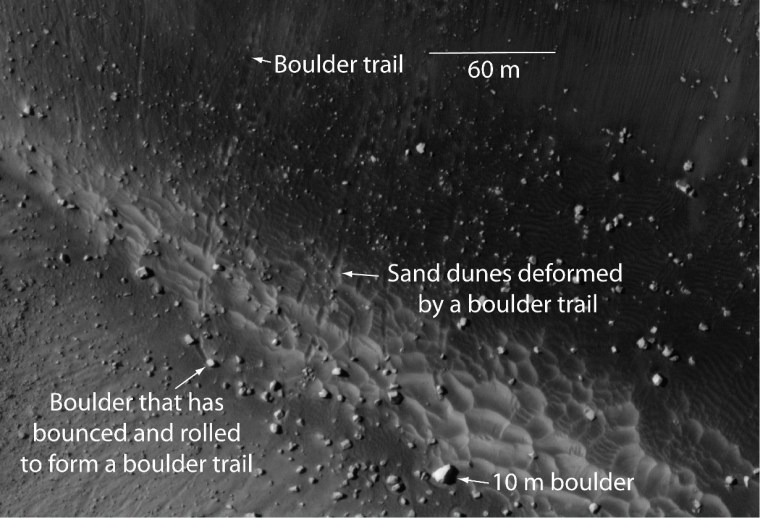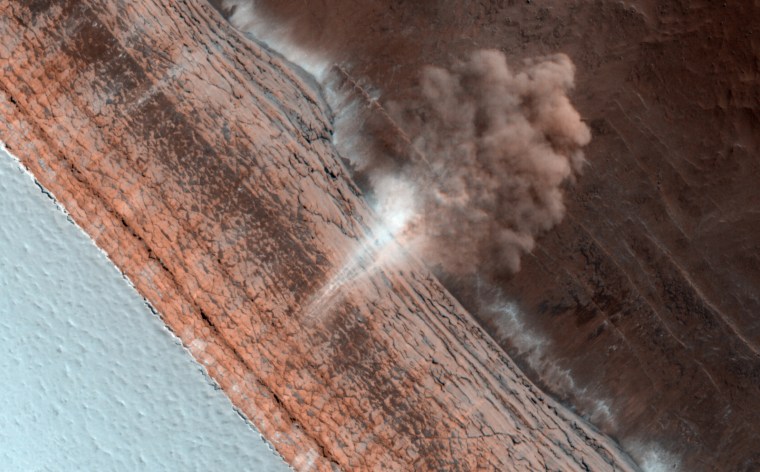
Geologists see signs that seismic shocks as powerful as magnitude-7 quakes on Earth have rumbled on the Red Planet recently, and such "marsquakes" could be a good thing for the search for life on Mars.
"The fact that Mars is geologically active means that it may offer geothermal power, subsurface liquid water, and extant life," Robert Zubrin, a rocket scientist and president of the nonprofit Mars Society, told me in an email.
The study that's getting Zubrin's juices flowing appears in Thursday's issue of the Journal of Geophysical Research-Planets.
A research team led by Gerald Roberts, a geologist at the University of London's Birkbeck center, charted ruptures in the Martian crust and the trails left behind by dislodged boulders, as seen in high-resolution images from NASA's Mars Reconnaissance Orbiter. The researchers compared the images with earthly faults to gauge what kinds of disturbances could have caused the changes they saw. They also looked at how much Martian dust was covering over the evidence, to estimate how long ago the disturbances happened.
Their conclusion? Powerful earthquakes have rattled Mars in recent geologic time, and may well be rumbling on Mars today.
The researchers acknowledged there could be other ways for boulders to loosen up and go tumbling on Mars. For example, ice or frozen soil could thaw along the rim of a crater, setting off an avalanche. Other researchers have said meteor strikes can cause avalanches as well. But Roberts and his colleagues saw a pattern in which the size and the number of dislodged boulders gradually decreased over a radius of 62 miles (100 kilometers), moving out from a central point on a fault line in Mars' Cerberus Fossae region. The biggest dislodged boulders were 65 feet (20 meters) wide.
"This is consistent with the hypothesis that boulders had been mobilized by ground-shaking, and that the severity of the ground-shaking decreased away from the epicenter of marsquakes," Roberts said in a news release from the American Geophysical Union, which publishes JGR-Planets.

The fact that the trails left behind by the boulders have not yet been erased by Martian winds suggested to the researchers that the rumbling happened relatively recently, perhaps sometime in the past few million years. And the pattern of the disruption suggested that the seismic activity at Cerberus Fossae hit magnitude 7, which is comparable to the strength of the quake that hit Haiti in 2010.
"The magnitude 7 is based on comparison on the size of the ruptured piece of crust," Roberts told me in an email. "On Earth, a rupture of several hundred kilometers and 15-kilometer depth would be typical for, say, a California magnitude-7 earthquake. The energy release is proportional to the size of the rupture. ... Thus, on Mars the same energy would be released, but the weaker gravity would mean the effect of shaking would be more severe in terms of vertical motions of particles on the surface — things would be thrown in the air more easily."
You might think that would be bad news for future Mars exploration. If you were an astronaut on Mars, a magnitude-7 quake is not the sort of thing you'd want to go through. If you're an astrobiologist, however, it might be very good news. Seismic activity could serve as a source of energy for microbes beneath the Martian surface. And as Zubrin suggests, seismic activity could be harnessed as an energy source for future settlements.
But is it for real? Right now, the evidence is based merely on image analysis rather than on-the-ground measurements. Roberts noted that the Mars Viking landers, which touched down on the Red Planet in 1976, had seismometers. They also had wind-speed sensors.
"The problem was that when the wind was strong ... the lander shook, setting off the seismometers," Roberts said. "The problem was the design, as it would have been better to have put the seismometers on the ground, as in the Apollo lunar instruments."
NASA has been considering a mission known as InSight (Interior Exploration using Seismic Investigations, Geodesy and Heat Transport) as one of three options for future funding as part of the space agency's Discovery Program. If InSight is selected, a spacecraft equipped with a seismometer, a heat-flow probe and other sensors would be sent to Mars in 2016.
NASA's Mars program is currently up in the air, but if InSight or something like it gets off the ground, we might find out how frequent and how powerful those marsquakes can get.
More about Mars:
- Seismic study hints at a rumbling Mars
- Martian life might thrive in lava tubes
- Are Martian volcanoes still ready to rumble?
- Volcano vents could point to Martian life
In addition to Roberts, the authors of "Possible Evidence of Palaeomarsquakes From Fallen Boulder Populations, Cerberus Fossae, Mars" include Brian Matthews, Chris Bristow, Luca Guerrieri and Joyce Vetterlein.
Alan Boyle is science editor for msnbc.com. Connect with the Cosmic Log community by "liking" the log's Facebook page, following @b0yle on Twitter or adding the Cosmic Log Google+ page to your circles. You can also check out "The Case for Pluto," my book about the controversial dwarf planet and the search for new worlds.